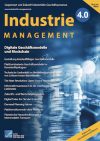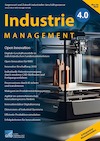Search


Bibtex
Cite as text
@Article{Brinker,+Beinke+Thomas+Westphal+Thoben+Gleede,
Cite-key = "Brinker2022",
Year= "2022",
Number= "6",
Volume= "IM 38",
Pages= "9-13",
Journal = "Industrie 4.0 Management",
Title= "Gestaltung kreislauffähiger Geschäftsmodelle - Einblicke aus Wissenschaft und Praxis",
Author= "Jonas Brinker, Jan Heinrich Beinke, Oliver Thomas,
Deutsches Forschungszentrum für Künstliche Intelligenz GmbH (DFKI),
Ingo Westphal, Klaus-Dieter Thoben, BIBA − Bremer Institut für Produktion und Logistik GmbH und Barbara Gleede, DECHEMA Gesellschaft für Chemische Technik und Biotechnologie e.V",
Doi= "https://doi.org/10.30844/IM_22-6_9-13",
Abstract= "Für Verbraucher, Unternehmen und politische Entscheidungsträger gewinnt das Thema Ressourceneffizienz zunehmend an Bedeutung. Dies hat unterschiedliche Gründe: Die unklare Versorgungssicherheit mit Rohstoffen führt zu höheren Materialpreisen. Neue Vorgaben für die Produktion, bspw. im Kontext der UN-Nachhaltigkeitsziele, sowie Erwartungsdruck seitens der Verbraucher erfordern die nachhaltigere Produktion von Gütern. Damit wird Nachhaltigkeit nicht nur zu einer notwendigen Voraussetzung für Unternehmen, sondern zu einem zentralen Wettbewerbsfaktor. Die damit verbundenen Konzepte und Ansätze wirken langfristig nur, wenn sie sich am Markt durchsetzen können, und werden erst damit zu „echten“ Innovationen [1]. Dafür bedarf es geeigneter Geschäftsmodelle, die für die Beteiligten vorteilhaft sind und sie zur Umsetzung und Nutzung motivieren.",
Keywords= "Kreislaufwirtschaft, Geschäftsmodelle, Nachhaltigkeit, Ressourceneffizienz",
}
Jonas Brinker, Jan Heinrich Beinke, Oliver Thomas,
Deutsches Forschungszentrum für Künstliche Intelligenz GmbH (DFKI),
Ingo Westphal, Klaus-Dieter Thoben, BIBA − Bremer Institut für Produktion und Logistik GmbH und Barbara Gleede, DECHEMA Gesellschaft für Chemische Technik und Biotechnologie e.V(2022): Gestaltung kreislauffähiger Geschäftsmodelle - Einblicke aus Wissenschaft und Praxis. IM 386(2022), S. 9-13. Online: https://doi.org/10.30844/IM_22-6_9-13 (Abgerufen 05.12.25)
Open Access
Abstract
Abstract
Für Verbraucher, Unternehmen und politische Entscheidungsträger gewinnt das Thema Ressourceneffizienz zunehmend an Bedeutung. Dies hat unterschiedliche Gründe: Die unklare Versorgungssicherheit mit Rohstoffen führt zu höheren Materialpreisen. Neue Vorgaben für die Produktion, bspw. im Kontext der UN-Nachhaltigkeitsziele, sowie Erwartungsdruck seitens der Verbraucher erfordern die nachhaltigere Produktion von Gütern. Damit wird Nachhaltigkeit nicht nur zu einer notwendigen Voraussetzung für Unternehmen, sondern zu einem zentralen Wettbewerbsfaktor. Die damit verbundenen Konzepte und Ansätze wirken langfristig nur, wenn sie sich am Markt durchsetzen können, und werden erst damit zu „echten“ Innovationen [1]. Dafür bedarf es geeigneter Geschäftsmodelle, die für die Beteiligten vorteilhaft sind und sie zur Umsetzung und Nutzung motivieren.
Keywords
Schlüsselwörter
Kreislaufwirtschaft, Geschäftsmodelle, Nachhaltigkeit, Ressourceneffizienz
References
Referenzen
[5] Osterwalder, A.; Pigneur, Y.: Business model generation: a handbook for visionaries, game changers, and challengers (Vol. 1). 2010.
[6] Geissdoerfer, M.; Pieroni, M. P.; Pigosso, D. C.; Soufani, K.: Circular business models: A review. In: Journal of Cleaner Production 277 (2020), 123741. https://doi.org/10.1016/j.jclepro.2020.123741.
[7] Nussholz, J. L.: A circular business model mapping tool for creating value from prolonged product lifetime and closed material loops. In: Journal of Cleaner Production 197 (2018), S. 185-194. https://doi.org/10.1016/j.jclepro.2018.06.112
https://doi.org/10.1080/ 21681015.2016.1172124

 English
English
